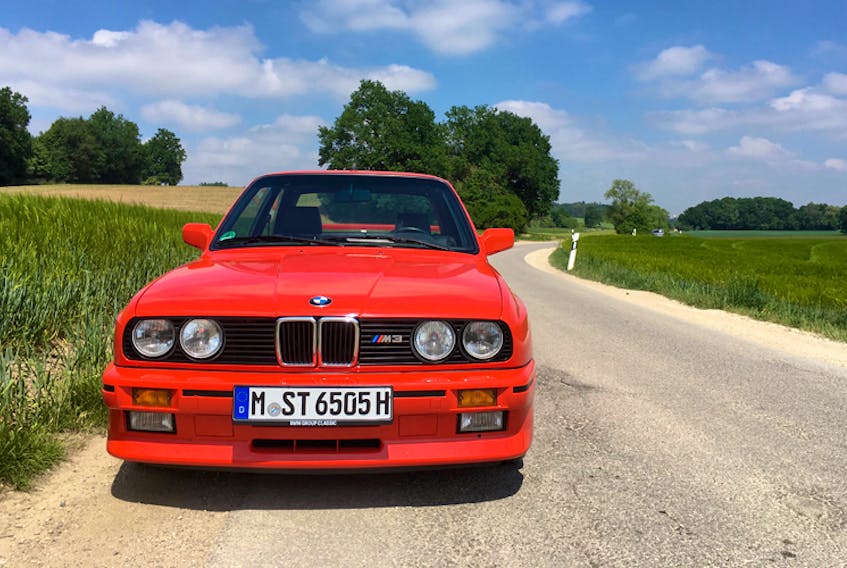MUNICH — It’s best not to think about how much a pristine classic like this is worth when its owner hands you the keys. But, you will. Three years ago, the first-generation BMW M3 spiked in value. Mint condition examples were offered at $100,000.
A late-model 2.5 Sport Evo, a high-power limited-edition, went for US$150,000. In 2007 you could’ve bought a good one for less than $17,000.
As an investment, original M3s — built in West Germany from 1986-1990 — have done far better than gold over the same time period, according to Hagerty’s valuation guide.
It’s absurd. Standing before me is a late ’80s BMW whose entire dashboard is made of a single piece of plastic that has warped with age. The wheels are cartoonishly tiny.

The whole car looks like it was designed with nothing more than a straight ruler and a pencil — which, actually, probably isn’t too far from the truth.
And yet, this is the machine that everyone remembers BMW’s M Division for. It’s the car that really gave the letter M its “Motorsport” connotation.
The M3’s door opens with a click-clack. Driver and passenger sit so close together they nearly rub shoulders. What’s most striking though is how little protection there is. The pillars holding up the roof are like bendy-straws. The door is wafer-thin. There are no airbags.
Now, you may be expecting a rip-snorting growl from the M3’s race-bred engine. But, no. It’s a 2.3-litre four-cylinder that makes just 192 horsepower at 6,750 rpm.

Don’t write the car off just yet. That motor, dinky though it is, was created by Paul Rosche. His list of credits include the V-12 engine in the McLaren F1 supercar, and the turbocharged motor (also a four-cylinder) that brought Nelson Piquet his 1983 Formula 1 Championship with Brabham. Asked how much horsepower that engine made, Rosche is said to have replied, “I can’t say, the dyno only goes up to 1,200.”
BMW built the original M3 to go racing. It wasn’t a commercial success in North America, where nobody wanted these expensive, underpowered little BMWs.
The company needed a car to beat the Mercedes 190E Cosworth in touring car championships. Motorsport division took the 3 Series, added some box fenders, glued in the windows to stiffen the chassis, added a plastic rear wing, bigger wheels, quicker steering, new suspension and topped it off with that high-revving Paul Rosche engine.

Racing rules meant BMW had to build road-going versions of this racecar, so they did, around 18,000 in total. To date, the original M3 is the most successful touring car of all time, racking up over 1,500 race wins.
Out among the rolling green hills to the north of Munich, the M3 is a little red wasp buzzing across the landscape. You can drive it like your always late for something. The motor will happily rev its guts out, without issue.
Less expected is how relaxed the car can be, given its racing pedigree. The windowsill is at perfect elbow-resting height. The ride is soft by modern standards, probably more comfortable than on a new 340i with all the sport package options.
The steering wheel is always moving, fidgeting in your hands. Tip into a corner, and there’s a bit of initial deadzone in the steering. The low, wide race-bred stance makes it feel Velcroed to the road. The steering gets meaty as load builds, but it can feel a little inert.
Only once you play with the throttle mid-corner does the handling make sense. Every minute accelerator input is felt through the steering, subtly adjusting the car’s line. It’s got perfect balance, an innate sense of under- and over-steer.
Surprisingly, it’s Paul Rosche’s motor that is the only disappointment. Yes, its response is immediate and tactile thanks to four individual throttles bodies. And yes, above 4,000 rpm there’s a broad, usable powerband.

But it just doesn’t have the torque to really make the most of the chassis. The experience is frustrating. The car is so close to being brilliant, transcendent, you can almost see perfection but can’t quite get there.
This criticism of Rosche though is not totally fair. He designed a 300-horsepower racing engine, to win races, which it did.
BMW had to neuter the motor, bringing output way down for road-going duty. With 300 horsepower, the original M3 might just be a transcendent experience. We can only dream.
Nobody could say M Division’s modern cars are underpowered or lacking in torque, but they could learn a thing or two about ride quality and handling finesse from their ancestor.
If, like most of us, you missed your chance to buy a first-generation M3, don’t fret.
Prices for third-generation M3s, made between 2000 and 2006, have been steadily rising but haven’t taken off. Yet.
Destination: BMW Classic Museum & Workshop
-Where? BMW Group Classic, Moosacher Strasse 66, Munich
-Tours? Yes, but call ahead to book
This pristine original M3 is part of the BMW Classic collection in Munich. Like all of the 1,500 cars and motorcycle under Classic’s care, it’s kept in fine running order.
Aside from maintaining all of BMW’s own cars, Classic will also restore your old BMW to like-new condition — although such service doesn’t come cheap.
The workshop and museum are now on the same campus. Classic moved to its current location in 2016, recommissioning an old building that, before WWI, was a factory building BMW airplane engines.
On any given day, 80-100 vehicles from the collection are on display in the museum. You’ll see everything from Elvis Presley’s 1957 BMW 507, to classic Minis, to a 1983 Brabham F1 racer, and the Paris-Dakar winning 1985 R80 G/S motorcycle.
If you’re in Munich, it’s well worth the trip.









